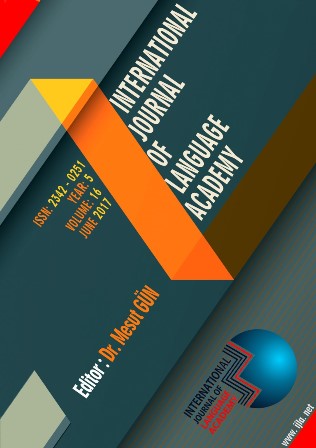Author :
Abstract
Keywords
Abstract
This study reports on a cross-sectional study conducted at the preparatory school of a state university in Turkey to examine the role of gender and L2 Proficiency on learners’ motivation and vision to learn English as a foreign language. While motivational dispositions of learners has been subject to research for several decades, understanding visualization has become a part of motivational studies in recent years and how it is affected by learners’ gender and L2 proficiency needs further research. This study aimed to contribute to the literature by studying some aspects of motivation and vision to find how they are affected by gender and L2 proficiency of learners. The results revealed that although gender had a main effect on Ideal L2 Self of learners in motivation, and on their Vividness of Imagery in vision; L2 proficiency was found to yield no main effect on any of the areas investigated.
Keywords
- Al-Shehri, A. H. (2009). Motivation and vision: The relation between the ideal L2 self, imagination and visual style. In Z. Dörnyei& E. Ushioda (Eds.), Motivation, language identity and the L2 self (pp. 164-171). Bristol, UK: Multilingual Matters.
- Busse, V. (2013). An exploration of motivation and self-beliefs of first year students of German. System, 41, 379-398.
- Chan, L. (2014). Effects of an imagery training strategy on Chinese university students‟ possible second language selves and learning experiences. In K. Csizer& M. Magid (Eds.), The impact of self-concept on language learning (pp. 357-376). Bristol, UK: Multilingual Matters.
- Cho, Y. G. (2013). L2 Learning Motivation and Its Relationship to Proficiency: A Causal Analysis of University Students‟ EIL Discourses. English Teaching, 68(1), 37-68.
- Council of Europe (2001). Common European Framework of Reference for Languages: Learning, teaching, assessment. Cambridge: Cambridge University Press.
- Csizer, K., &Lukacs, G. (2010). The comparative analysis of motivation, attitudes, and selves: The case of English and German in Hungary. System, 38, 1-13.
- Csizer, K., &Magid, M. (Eds.). (2014). The impact of self-concept on language learning. Bristol, UK: Multilingual Matters.
- Dörnyei, Z. (2005). The psychology of the language learner: Individual differences in second language acquisition. Mahwah, NJ: Erlbaum.
- Dörnyei, Z. (2009). The L2 motivational self system. In Z. Dörnyei& E. Ushioda (Eds.), Motivation, language identity and the L2 self (pp. 9-42). Bristol, UK: Multilingual Matters.
- Dörnyei, Z., & Ushioda, E. (2011). Teaching and researching motivation (2nded.). Harlow, UK: Pearson Education.
- Dörnyei, Z., & Chan, L. (2013). Motivation and vision: An analysis of future L2 self images, sensory styles, and imagery capacity across two target languages. Language Learning, 63, 437-462.
- Dörnyei, Z. (2014). Future self-guides and vision. In K. Csizer& M. Magid (Eds.), The impact of self-concept on language learning (pp. 7-18). Bristol, UK: Multilingual
- Gardner, R. C., & Lambert, W. E. (1972). Attitudes and motivation in second language learning. Rowley, MA: Newbury House Publishers.
- Hall, E., Hall, C., & Leech, A. (1990). Scripted Fantasy in the Classroom. London: Routledge.
- Henry, A. (2009). Gender differences in compulsory school pupils‟ L2 self-concepts: A longitudinal study. System, 37, 177-193.
- Henry, A. (2010). Gender differences in L2 motivation: A reassessment. In S. Davies (Ed.), Gender gap: Causes, experiences and effects (pp. 81-102). New York: Nova Science.
- Henry, A., & Cliffordson, C. (2013). Motivation, gender and possible selves. Language Learning, 63, 271-295
- Higgins, E.T. (1987). Self-discrepancy: A theory relating self and affect. Psychological Review, 94, 319-340.
- Islam, M., Lamb, M., & Chambers, G. (2013). The L2 motivational self system and national interest: A Pakistani perspective. System, 41, 231-244.
- Kormos, J., & Csizer, K. (2008). Age-related differences in the motivation of learning English as a foreign language: attitudes, selves and motivated learning behaviour. Language Learning, 58, 327-355.
- Kormos, J., Kiddle, T., &Csizer, K. (2011). Systems of goals, attitudes, and self-related belifs in second-language-learning motivation. Applied Linguistics, 32, 495-516.
- Magid, M. (2014). A motivational programme for learners of English: An application of the L2 Motivational Self System. In. K. Csizer& M. Magid (Eds.), The impact of selfconcept on language learning (pp. 333-356). Bristol, UK: Multilingual Matters.
- Markus, H., &Nurius, P. (1986). Possible selves. American Psychologist, 41, 954-969.
- Moulton, S. T., &Kosslyn, S. T. (2009). Imagining predictions: mental imagery as mental emulation. Philosophical Transactions of the Royal Society B, 364, 1273-1280.
- Sampson, R. (2012). The language-learning self, self-enhancement activities, and self perceptual change. Language Teaching Research, 16, 317-335.
- Taguchi, T., Magid, M., &Papi, M. (2009). The L2 motivational self system among Japanese, Chinese and Iranian learners of English: a comperative study. In Dörnyei, Z., Ushioda, E. (Eds.), Motivation, Language Identity and The L2 Self. (pp. 66-97). Bristol, UK: Multilingual Matters.
- Wenger, E. (1998). Communities of Practice: Learning, Meaning and Identity. Cambridge: Cambridge University Press.
- You, C. J., Dörnyei, Z., &Csizer, K. (2016). Motivation, vision, and gender: A survey of learners of English in China. Language Learning, 66(1), 94-123.
- You, C. J., & Dörnyei, Z. (2016). Language learning motivation in China: Results of a large scale stratified survey. Applied Linguistics, 37(4), 495-519. APPENDIX MOTĠVASYON ANKETĠ





